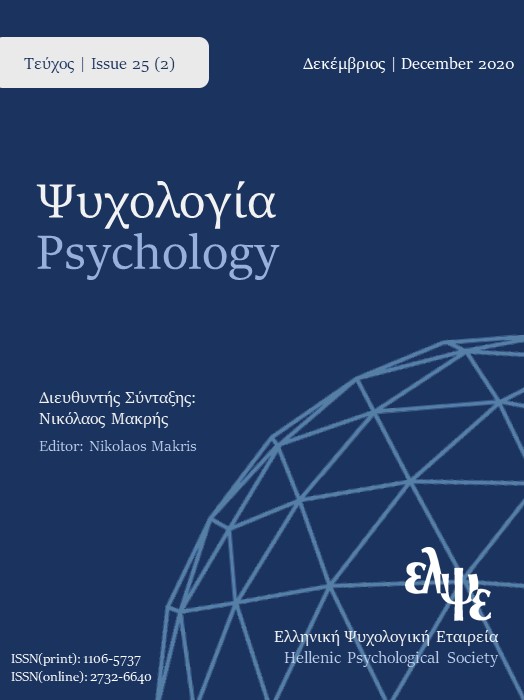Οι εξωσωματικές εμπειρίες ευνοούν την παγίωση της συναισθηματικής μνήμης

Περίληψη
Η ιδιοδεκτικότητα αντανακλά την ικανότητά μας να αναγνωρίζουμε το σώμα μας σε μια συγκεκριμένη τοποθεσία, επιτρέποντάς μας να επικοινωνούμε με τον κόσμο. Τα συναισθήματα επιφέρουν ισχυρό αντίκτυπο στη μνήμη και στην ιδιοδεκτικότητα. Παρουσιάζει ενδιαφέρον ότι η θερμοκρασία του δέρματος μπορεί τουλάχιστον εν μέρει να μεσολαβήσει σε αυτή την επίδραση. Προηγούμενες μελέτες έχουν διαπιστώσει ότι οι εξωσωματικές εμπειρίες (out-of-body experiences, OBE) έχουν αρνητικό αντίκτυπο στην κωδικοποίηση πληροφοριών και προκαλούν πτώση της θερμοκρασίας του δέρματος. Στην παρούσα μελέτη σχεδιάστηκε μια νέα μέθοδος για την πρόκληση OBE και διερευνήθηκε η επίδρασή τους σε διαφορετικό στάδιο και τύπο επεξεργασίας μνήμης (παγίωση της συναισθηματικής μνήμης) και στη θερμοκρασία του δέρματος. Στο πείραμά μας παρουσιάσαμε τρεις τύπους συναισθηματικών εικόνων (ουδέτερες, ευχάριστες, δυσάρεστες) προτού προχωρήσουμε στην πρόκληση OBE και εξετάσουμε τη μνήμη αναγνώρισης των συμμετεχόντων μας σε μια δοκιμασία ανάκτησης. Σε όλο το πείραμα, η θερμοκρασία του δέρματος τόσο στο λαιμό όσο και στο χέρι μετρήθηκε με iButtons. Οι επιδόσεις των συμμετεχόντων υπολογίστηκαν χρησιμοποιώντας d-prime και οι στατιστικές αναλύσεις περιελάμβαναν ανάλυση ANOVA, εξετάζοντας τη σχέση μεταξύ της βαθμολογίας στο ερωτηματολόγιο OBE, της απόδοσης και της θερμοκρασίας του δέρματος. Συγκρίναμε επίσης τις διαφορές μεταξύ της πειραματικής ομάδας και της ομάδας ελέγχου. Τα αποτελέσματα έδειξαν ότι το OBE ευνοεί την παγίωση της συναισθηματικής μνήμης και προκαλεί αύξηση της θερμοκρασίας. Μελλοντικές μελέτες θα πρέπει να επεκτείνουν τα ευρήματά μας, να αποκλείσουν ότι οι συμμετέχοντες που βιώνουν OBE θα μπορούσαν να έχουν εκ των προτέρων καλύτερη μνήμη ή ότι η θερμοκρασία θα μπορούσε να αυξηθεί λόγω άλλων λόγων.
Λεπτομέρειες άρθρου
- Πώς να δημιουργήσετε Αναφορές
-
Δαουλτζής Κ. Χ., Bogemann, S. A., Onuki, Y., Meeter, M., & Van Der Werf, Y. (2020). Οι εξωσωματικές εμπειρίες ευνοούν την παγίωση της συναισθηματικής μνήμης. Ψυχολογία: το περιοδικό της Ελληνικής Ψυχολογικής Εταιρείας, 25(2), 13–33. https://doi.org/10.12681/psy_hps.25576
- Ενότητα
- ΕΙΔΙΚΟ ΑΦΙΕΡΩΜΑ

Αυτή η εργασία είναι αδειοδοτημένη υπό το Creative Commons Attribution-ShareAlike 4.0 International License.
Το περιοδικό ΨΥΧΟΛΟΓΙΑ έχει υιοθετήσει μία πολιτική Platinum open-access. Τα έξοδα υποβολής, επεξεργασίας ή δημοσίευσης των εργασιών καλύπτονται από την Ελληνική Ψυχολογική Εταιρεία. Τα πνευματικά δικαιώματα των δημοσιευμένων εργασιών προστατεύονται από την άδεια 'Creative Commons Attribution-ShareAlike 4.0 International'. Οι Συγγραφείς διατηρούν τα Πνευματικά Δικαιώματα και χορηγούν στο περιοδικό το δικαίωμα της πρώτης δημοσίευσης. Η άδεια αυτή επιτρέπει σε τρίτους, να χρησιμοποιούν την εργασία σε οποιαδήποτε μορφή, με την προϋπόθεση της διατήρησης των διατυπώσεων που προβλέπονται στην άδεια σχετικά με την αναφορά στον αρχικό δημιουργό και την αρχική δημοσίευση στο περιοδικό ΨΥΧΟΛΟΓΙΑ. Επιπλέον, κάθε διανομή της εργασίας οφείλει να γίνεται με τους ίδιους όρους διανομής, δηλαδή με την ίδια άδεια Creative Commons.




